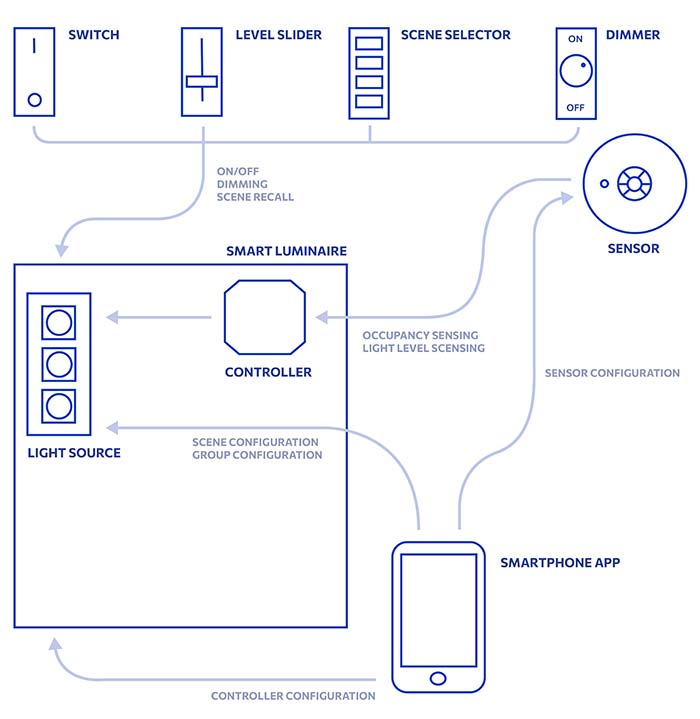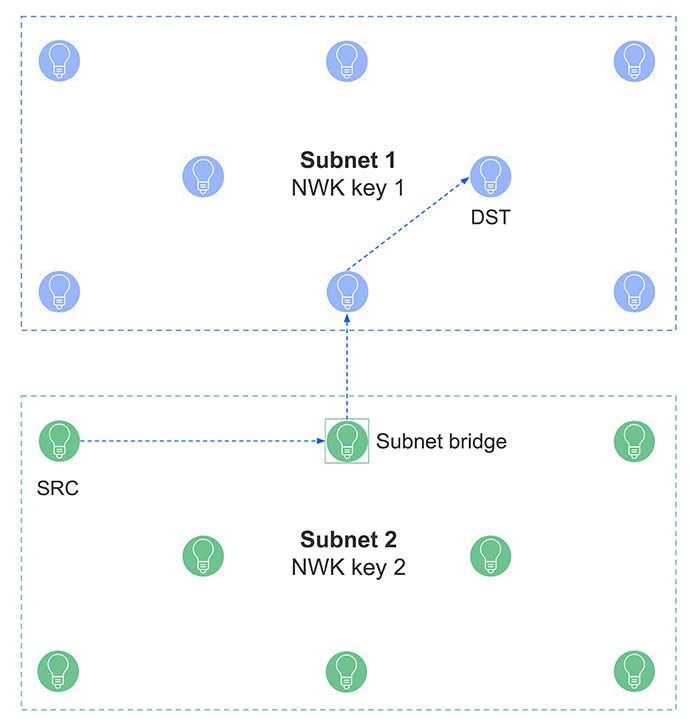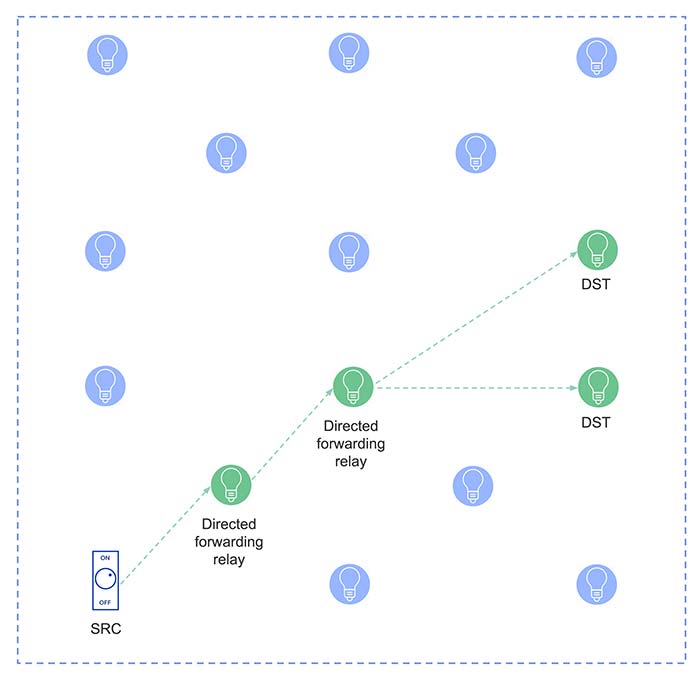Traditionally, artificial lighting was used solely to illuminate the darkened interior of a building. While this will always be its primary function, the requirement to make buildings ‘smart’ has resulted in lighting being reimagined so that it is used more efficiently. This article looks at how Bluetooth mesh networking has enabled smart lighting applications and the additional benefits the most recent editions of the standard will bring. It also presents a development kit from Silicon Labs, which can be used to get a Bluetooth mesh smart lighting solution up and running quickly.
The rationale for smart lighting
Interior lighting is a vital requirement in buildings – without it, large parts of the interiors of a building become either temporarily (after dark) or completely unusable. Lighting can account for up to 40% of the energy costs of running a building. A significant amount of this energy is wasted by using lights to illuminate areas that are not being used or do not require it because there is sufficient ambient light. It is estimated that using sensors to manage light more sustainably reduces its cost by over 30%. Using this approach to lighting also brings other advantages; for example, it allows brightness and coloring to be tuned to create more comfortable and productive spaces for occupants.
The environmental impact of this wasted energy is increasingly leading to the introduction of regulations such as Title 24 in California requiring lighting luminaires and switches to include occupancy and ambient light sensors to ensure that interior illumination is used as efficiently as possible. However, the cost of installing new network cables to control the sensors housed in smart lighting luminaires and switches makes this approach unrealistic for existing buildings – so wireless connectivity is the preferred option.
This lower-cost approach has several other advantages, including fast deployment and easy reconfiguration. Wireless communication also allows lighting infrastructure to be used for other purposes, including indoor location finding for occupants, asset tracking, data collection for preventive maintenance, better space utilization and implementing more effective lighting plans. In addition, wireless sensors housed in lighting luminaries could also be inputs to other smart building controls like heating and air conditioning. The main components of a smart lighting system are shown in Figure 1.
Bluetooth mesh was designed for smart applications
A wireless communications technology for smart lighting must be reliable, responsive, secure and scalable. Life gets particularly challenging for the wireless designer when supporting multicast operations with groups of devices. For example, consider a wireless light switch which operates multiple lights. Each light must illuminate simultaneously (with imperceptible delay) when the button is pressed. This is difficult to achieve, especially when walls and other environmental factors can attenuate or interfere with signals and become even more so when using a dimmer switch. Some wireless technologies, initially designed for more straightforward use cases, like smart thermostats, can struggle to meet these requirements. However, Bluetooth mesh was designed to support these features making it ideal for smart lighting applications, delivering:
- Smartphone connectivity: Simplifying commissioning and maintenance
- Optional gateways: Bluetooth mesh removes the requirement for gateways which can be challenging to build and maintain.
- Inbuilt profile selection: Scenes and schedules are built into individual nodes.
- Scalability and security: Support up to thousands of nodes with two layers of security and privacy built-in.
- Extendibility and flexibility: Making it easy to add nodes, partition them based on space requirements or reconfigure them based on user preferences.
- Value–added services: Enables luminaires to be used as beacons for other applications like direction finding, people counting and occupancy mapping
Bluetooth mesh 1.1 brings additional benefits
The latest update to the Bluetooth mesh protocol – version 1.1 will bring further enhancements to smart applications, including:
Device firmware update (DFU)
The DFU feature of Bluetooth mesh adds a standard way to update the firmware on the network’s nodes. Its functionality includes checking the availability of firmware updates, acquiring binary images, distributing the firmware code, updating selected nodes and coordinating updates to nodes. In addition, the DFU feature uses a multicast firmware distribution capability of enabling a single firmware image to be distributed to multiple devices in one go, substantially reducing the manual effort required to keep the network up-to-date.
Remote provisioning (RPR)
With Bluetooth mesh 1.0, each node to be provisioned must be in the range of the provisioner; Bluetooth mesh 1.1 features RPR that provisions and configure the network through a proxy node, eliminating the requirement to be within the range of the provisioner radio. RPR allows for faster and simpler network setup through multi-hop device provisioning, which enables the provisioning of nodes through the mesh network, thereby reducing installation time and cost for large networks. The plug and play feature of RPR also automatically detects changes to the physical composition and subsequent mesh composition state, and updates the active composition data state to reflect these changes. This avoids the requirement to reset, reprovision, and reconfigure a device.
Subnet bridging
In Bluetooth mesh 1.0, subnets were completely isolated from each other. Bluetooth mesh 1.1 addresses this shortcoming with subnet bridging, allowing communication between devices in different subnets. Subnet bridges relay traffic between different subnets. The network planner must select bridge nodes in advance. These nodes store bridging tables containing network (NWK) keys, device addresses in both subnets and information about which direction the traffic can flow (Figure 2). Subnet Bridging allows seamless communication across different subnets without compromising security features that are usually provided by using subnets and isolation.
Certificate-Based Provisioning (CBP)
Provisioning enables a device to be part of a network by providing network and application security keys. Bluetooth mesh 1.1 CBP introduces a new method that uses certificates during provisioning to authenticate devices being added to the network. X.509 certificates are stored either in the cloud, or with the provisioner, and contain a node’s public key and unique user ID (UUID) signed by a certification authority (CA) or device vendor. In addition, each node has a unique private key matching the public key in the X.509 certificates, and these should be stored in secure storage (not in flash memory). As part of the provisioning process, Provisioner gets the certificate from the node, validates it, and then the device is added onto the network. As a result, CBP provides a superior authentication scheme and enables bulk commissioning, especially when combined with RPR.
Directed Forwarding
Bluetooth mesh 1.0 introduced managed flooding that made multiple paths available for a message to reach destinations; This is a practical, reliable and low-maintenance method for delivering messages. However, under specific configurations, managed flooding resulted in an inefficient path of travel for messages. Bluetooth mesh 1.1 introduces a Directed Forwarding feature (Figure 3) to improve the scalability of the network, adding Directed Forwarding node types, directed forwarding configuration models, paths and lanes for optimized message delivery, and ways to create, maintain and validate paths and lanes.
Private Beacons
Nodes in a Bluetooth mesh network can act as beacons and transmit static information about device data, location or point of interest information. Unencrypted static information poses privacy risks by allowing tracking of the network itself, devices in a network or device users. Bluetooth mesh 1.1 encrypts static information to prevent privacy risks during beaconing. Data is encrypted using PrivateBeaconKey, derived from the main network key and a 13-octet random number. Bluetooth device addresses change periodically to ensure obfuscated data so that information can only be decrypted by nodes that are part of the network. Private beaconing ensures that devices or users of those devices in a network cannot be tracked using static information contained in a beacon message.
Implement a Bluetooth mesh smart lighting solution quickly.
Silicon Labs’ Blue Gecko Bluetooth SoC wireless starter Kit is a quick and easy way to start evaluating and developing Bluetooth mesh lighting applications. It features the EFR32xG24 +10 dBm Pro Kit (Figure 4) and includes Zigbee and Thread software stacks, sample code and an integrated debug adapter. The kit also includes support for Bluetooth low energy (LE). Multiple radio boards enable developers to create a mesh network while evaluating the benefits of the EFR32MG system-on-chip (SoC) and auxiliary modules. With the supporting Simplicity Studio suite of tools, developers can also explore the advantages of graphical wireless application development, mesh networking debug and packet trace, and visual energy profiling and optimization.
Conclusion
Bluetooth mesh networking was designed to enable applications like smart lighting but had shortcomings that increased network installation and reconfiguration complexity. Bluetooth mesh 1.1 has introduced various features which overcome these, making smart lighting applications more straightforward, scalable and secure.
Author: Aashish Chaddha, Product Marketing Manager, Silicon Labs





